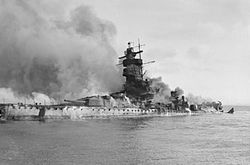Latin America during World War II
| Latin America during World War II | |
|---|---|

Following the Battle of the River Plate, the German ship Admiral Graf Spee was scuttled by her crew off Montevideo, Uruguay, on December 17, 1939.
|
|
| Location | Latin America |
| Date | 1939–1945 |
| Events | The St. Louis Affair – June 1939 Battle of the River Plate – December 13, 1939 Operation Bolivar begins – May 1940 The Lüning Affair – August 1942 The sinking of U-176 – May 15, 1943 Revolution of '43 – June 4, 1943 The Strike of Fallen Arms – May 5–11, 1944 The Panama Canal strike – June 1945 |
The history of Latin America during World War II is important because of the significant economic, political, and military changes that occurred throughout much of the region as a result of the war. In order to better protect the Panama Canal, combat Axis influence, and optimize the production of goods for the war effort, the United States through Lend-Lease and similar programs greatly expanded its interests in Latin America, resulting in large-scale modernization and a major economic boost for the countries that participated.
Strategically, Panama was the most important Latin American nation for the Allies because of the Panama Canal, which provided a link between the Atlantic and Pacific Oceans that was vital to both commerce and defense. Brazil was also of great importance because of its having the closest point in the Americas to Africa where the Allies were actively engaged in fighting the Germans and Italians. For the Axis, the Southern Cone nations of Argentina and Chile were where they found most of their support, and they utilized it to the fullest by interfering with internal affairs, conducting espionage, and distributing propaganda.
Brazil and Mexico were the only countries to send troops to the European Theater; however, several countries had skirmishes with German U-Boats and cruisers in the Caribbean and South Atlantic. Mexico sent a fighter squadron of 300 volunteers to the Pacific, the Escuadrón 201 were known as the Aztec Eagles (Águilas Aztecas).
...
Wikipedia
